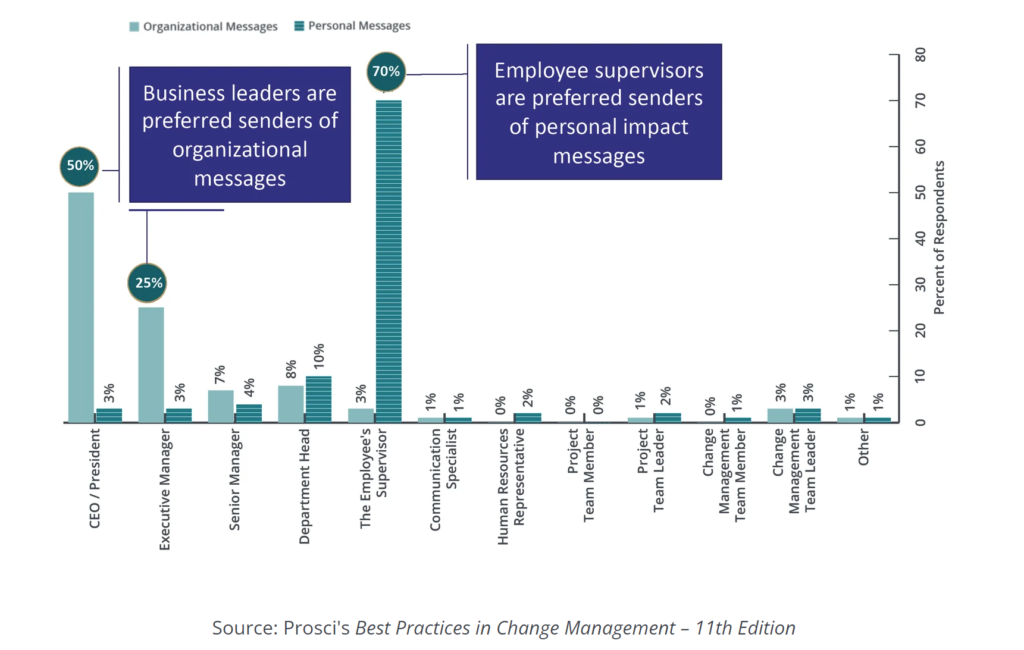At first glance, many misunderstand ERP change management as a simple technology implementation, but it is well known that an ERP transformation initiative represents one of the most complex and cross-functional undertakings an organization can embrace. Still, the returns on these initiatives have tremendous potential to enhance the competitive advantage of an organization. Therefore, manufacturers should acknowledge that this entails substantial process changes, and ultimately, success hinges on people embracing and thriving within this transformation.
A McKinsey report reported that employee resistance or management behavior caused 72% of failed change programs. This occurs because transitioning the human side entails shifting from old habits to behavior changes that define the established culture. ERP change management offers an opportunity for transformational changes. This change is hard for everyone because only babies with wet diapers enjoy change. Therefore, manufacturers must dedicate themselves to investing in the human aspect of change and engage employees from all departments. Manufacturers can truly achieve the intended value (ROI) from the ERP transformational initiative only by adopting a framework that offers a methodical structure to ensure employees positively embrace the change.
“The achievements of an organization are the results of the combined efforts of each individual.”
– Vince Lombardi, Head Coach and General Manager of the Green Bay Packers
Many businesses have enlisted espi’s ADKAR® (PROSCI®) Certified Change Management Practitioners to accompany them on their ERP transformation journey. The ADKAR® model serves as a structured framework for addressing the human aspect of ERP change management, with the aim of achieving the desired outcome and reducing resistance and disruption to a minimum. This blog thoroughly describes the five pillars of success in the ADKAR® model and highlights why espi’s manufacturing clients, who embrace this model, acknowledge the substantial value their ERP initiatives bring.
The Preferred Choice for Manufacturers & Change Management Consultants: The ADKAR® Model
ADKAR® is an acronym representing A – Awareness, D – Desire, K – Knowledge, A – Ability, and R – Reinforcement, comprising a methodological framework for addressing the human side of change. Adapting this framework throughout the ERP initiative’s lifecycle (from inception, blueprinting, realization, validation, go-live, to stabilization) plays a critical role in achieving success.
Manufacturers and ERP implementation consultants can enhance the likelihood of successful ERP change management by actively addressing each component of the ADKAR® model by PROSCI® to boost staff acceptance of the ERP system.
When the five pillars of the ADKAR® model collaborate, employees realize that a new ERP system doesn’t transform them into mere pencil pushers. Instead, this model helps them recognize their integral role in a company’s data collection and management strategy. In essence, ERP change management and implementation empower team members to contribute to a business’s growth.
While every team member shares the responsibility of inputting timely, accurate, and complete data, the duty of motivating the team squarely rests on leadership’s shoulders. Implementing this model can be transformational, especially for those in middle management. Read on for more information about each pillar of success and strategies to achieve actionable ERP data.
1. A – Awareness
Awareness refers to a person’s understanding of why the change is happening, its nature, and the risks associated with not changing. Failing to inform the organization about impending change increases the risk of encountering resistance. This highlights the crucial nature of communicating the need for change, which extends beyond mere communication. Employees should not only grasp the need for change but also agree with the changes themselves.
Organizational leaders can instill awareness in their teams by addressing common W- and H- questions. Leaders need to comprehend what is changing, why the change is necessary, how it is occurring, and when they should finalize it. Once management has a clear understanding of the answers to these questions, they can communicate effectively with their teams.
However, communicating change and raising awareness is not as straightforward as sending a memo, as it often meets resistance. It is essential to be responsive to employees’ questions and concerns during ERP system implementation. Instead of sending memos, leaders should invite employees to company town halls, lunch-and-learns, one-on-one discussions, and spotlight meetings. In these meetings, leadership can elucidate the reasons for the change and, in this case, the competitive advantages offered by the ERP system.
These meetings also provide an opportunity to encourage teams to ask questions about implementation, the rationale behind the change, and whether it will address issues related to their specific use cases. Through this demonstration of humble leadership, you can invite your team to be a part of the changes that need to be made.
Throughout this process, business executives, leaders, and project sponsors play essential roles. They must actively participate in ERP change management and remain visible to their staff, demonstrating a strong commitment to the ERP transformational initiative, and communicating the need for change.
According to a new PROSCI® survey, excellent change management programs where leaders are visible, lead 88% of participants to meet or exceed objectives. A similar study on change management best practices expands on the increased potential for successful change management programs through discussion of who employees prefer to deliver impact messages. When the message relates to organizational impact, 50% of respondents preferred to hear from the CEO or President of their company. In relation to personal impact messages, 70% preferred to hear from their supervisor directly.

2. D – Desire
In the ADKAR® model by PROSCI®, desire represents the participants’ personal choice and willingness to engage and support the change. While employees may be aware that a change is underway, it does not guarantee their desire for it. It’s crucial to acknowledge that assuming a desire to change can be detrimental. This validation and explicit communication need to occur at all levels of the organization, from the C-Suite to hourly employees.
When employees genuinely desire the change and believe it will benefit both them and the organization, you have a better chance of engaging them in the ERP implementation process. They will be more enthusiastic and receptive to the impending changes and will take ownership of the process.
Failure to tap into employees’ desires can breed resistance to the process. This resistance often stems from limited exposure to the new system or concerns about job functions and security post-implementation.
Hence, ERP change management consultants and organizational leaders must deeply understand both the company’s motivation for the change and what will inspire desire among the team. You and your digital transformation consultant can achieve this by explaining why the change is vital to those affected. A 2023 PROSCI® benchmarking research found that most instances of resistance are avoidable when change management consultants implement practical change management principles and practices.
To minimize resistance from the offset, adopt the following practices:
- Take a deep dive to understand the source of resistance.
- Recruit resistance managers from leaders and Human Relations to support the change.
- Encourage open discussion at every level to facilitate ownership of the change process.
- Clearly and repeatedly demonstrate the benefits of the change to the employees.
Humble leadership is pivotal in this process, blending authentic leadership and servant leadership. When implementation leadership rejects the idea of being all-knowing and embraces feedback through inquiry, team members develop a strong sense of ownership. This fosters robust cross-functional relationships that are essential for effective decision-making and problem-solving.
3. K – Knowledge
Without employees acquiring the requisite knowledge, the ERP change management process is doomed to failure. There are several layers of knowledge management during the ERP implementation:
- Practical Knowledge – The “How-To”: Team members must understand the mechanics of how to navigate and perform the tasks with the new system.
- End-to-End Understanding: Knowing how your work impacts both upstream and downstream processes is crucial, especially when reimagining and redesigning value streams. This knowledge ensures high-quality data input, fueling the ERP system’s performance.
- Foundational Knowledge: This encompasses core concepts and best practices essential for leveraging advanced tools. For instance, APICS supply chain training provides valuable insights into planning and supply chain management.
- Data Knowledge: Understanding where data resides in the system, including Master Data and Transactional Data files, helps employees grasp the ERP system’s advantages and limitations. In these digital transformation initiatives, there must be a deep understanding and appreciation at a grassroots level that data needs to be accurate, timely, and complete. Without that, these initiatives will not deliver the expected value.
- Analysis Knowledge: ERP systems offer powerful analytical tools for decision-making due to vast amounts of stored data. However, many lack the foundational knowledge required to be effective analysts.
Besides technology, process, and system knowledge, soft skills education is essential throughout the ERP project stages. Educating key leaders on tools and techniques for managing behavioral change is crucial.
Additionally, employees need mentoring and support structures to gain and retain knowledge. A knowledgeable digital transformation consultant overseeing ERP change management will assess employees’ skills to determine their needs. They will then employ adult education principles and tools like Conference Room Pilots to support effective change management.
4. A – Ability

Ability means putting knowledge into action, and ensuring employees can operate the ERP independently. To bridge the gap between knowledge and ability, an ERP change management practitioner helps employees connect the dots. Practice runs may be necessary to identify what works and what doesn’t.
At espi, we use a series of Conference Room Pilots to achieve this. Employees are expected to have a basic system understanding before taking a deep dive into the business processes. These pilots simulate a “day in the life” scenario, providing real-life experience with on-the-fly changes. Typically, we conduct three pilots, with the goal of full system utilization by the 3rd pilot, independent of the digital transformation consultant’s assistance.
Throughout, the system may require adjustments, and performance tracking and constructive feedback are essential. Given the complexity of ERP software, consider implementing it in stages to catch and address issues early in the implementation plan.
5. R – Reinforcement
Lastly, reinforcement encompasses internal and external forces that sustain change, including rewards, recognition, and inner satisfaction. Once the system operates smoothly, your change management consultant will reinforce positive behavior to prevent employees from reverting to the old system. Establishing a routine is crucial for habit formation.
The speed of habit formation depends on various variables, such as the reward value attached to the behavior. Intense feelings of accomplishment or alignment with annual performance reviews can accelerate learning.
Business leaders and consultants should publicly praise, reward, and provide positive feedback while addressing mistakes privately. Monitoring these behaviors, collecting regular feedback, and refining the system extend well beyond the ERP’s go-live date to ensure full employee adoption. This is vital because ERP change management is an ongoing process, and the work continues until the system reaches full stability.
How espi’s Certified Change Management Practitioners Help With ERP Change Management
espi has practiced change management for over 20 years, deploying these change management frameworks and techniques in over 100 projects, including Infor CloudSuite ERP, Microsoft Dynamics ERP, SAP, Oracle, and other ERP systems, as well as CRM, APS, and WMS systems. We take a holistic approach to ERP change management, leveraging our expertise in innovation and operational excellence to deliver value in large-scale transformational initiatives.
This ERP change management consulting model has played a crucial role in the success of many clients, such as Just Born, a family-owned candy manufacturer based in Bethlehem, Pennsylvania. espi facilitated a business transformation initiative centered around ERP implementation, helping the organization advance in various areas.
The espi team uses the PROSCI ADKAR® model to create awareness, desire, knowledge, ability, and reinforcement for ERP change, enhancing value creation. We recognize that the success of the project hinges on the success of the people involved. If you seek thevrealization of benefits from your ERP transformational initiatives, contact espi change management consultants today.

